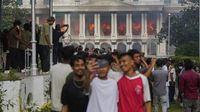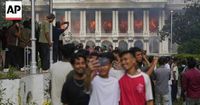From the Andes to the Himalayas, a new kind of protest is sweeping the globe, and it’s led by a generation that’s never known a world without the internet. Over the past several months, young people—proudly identifying themselves as “Gen Z,” those born roughly between 1996 and 2010—have taken to the streets in countries as far-flung as Madagascar, Nepal, Indonesia, the Philippines, Kenya, Peru, and Morocco. Their grievances are as varied as their homelands: corruption, inequality, joblessness, government neglect, and a political class that seems, to many, hopelessly out of touch. But the energy and tactics uniting these movements feel unmistakably modern, and the symbols they rally around are as likely to come from Japanese manga as from any political manifesto.
In mid-October 2025, the world’s attention turned to Madagascar, where President Andry Rajoelina was forced out of office—and out of the country altogether—following a dramatic military mutiny. According to the Associated Press, the weeks leading up to this upheaval were marked by mass demonstrations led by “Gen Z Madagascar,” who drew inspiration from similar youth-led uprisings in Nepal and Sri Lanka. What began as protests against basic service failures, like recurring water and electricity outages, quickly snowballed into a sweeping rejection of the political establishment. “We realized that we are global citizens and the digital space connects us all and plays a powerful role across the world,” Nepali protester Yujan Rajbhandari told AP, capturing the sense of global solidarity that’s become a hallmark of these movements.
It’s a pattern that’s played out elsewhere. In Nepal, months of unrest—sparked by government corruption and capped by a deadly crackdown on September 8, 2025—culminated in the resignation of the prime minister. Protesters there demanded not only treatment for the wounded and proper records of casualties, but also legal action against those responsible for ordering security forces to fire on demonstrators. As in Madagascar, the protests in Nepal were largely leaderless, their ranks filled with young people who saw themselves as part of a worldwide movement for change. “What connects these youth-led protests is a shared sense that traditional political systems aren’t responsive to their generation’s concerns, whether that’s corruption, climate change, or economic inequality,” explained Sam Nadel, director of Social Change Lab, in comments to the Associated Press. “Protest then becomes the logical outlet when institutional channels feel blocked.”
The sense of global connection is more than just rhetoric. Across continents, Gen Z protesters have adopted a striking symbol: a black flag emblazoned with a grinning skull and crossbones wearing a straw hat—the emblem of Luffy’s pirate crew from the Japanese manga and anime series One Piece. In Nepal, this flag was hung on the gates of the Singha Durbar, the seat of government, and on ministries that were later torched during the unrest. In Indonesia, the Philippines, Morocco, Madagascar, and Peru, the same flag has been spotted at rallies, waved by crowds demanding everything from better public services to an end to corruption and political violence. “We’re fighting the same battle—against corrupt officials who, in our case, are also killers,” said David Tafur, a 27-year-old protester in Lima, Peru, as reported by AP. Tafur’s words reflect not only outrage at the deaths of civilians during protests but also frustration with a government seen as unresponsive and self-serving.
The adoption of the One Piece flag is more than just pop culture flair. As Dr. Matt Frierdich, an assistant professor at the University of Missouri, explained to the Maneater, such symbols help “push individuals out of a state of helplessness and into action.” The flag, he said, speaks a language young people understand, one that’s easily meme-ified and shared across borders. “Seeing the skull and crossbones, knowing the references, speaking the language, knowing the continuity, but also the ways that you translate things into your own experience that [are] not universal—I think young people are comfortable meme-ifying things like that.”
Social media, too, has been a powerful tool for Gen Z activists. While previous protest movements—like the Arab Spring or Hong Kong’s Umbrella Revolution—used online platforms to organize, today’s youth are digital natives, using TikTok, Instagram, X, and even Discord to coordinate, mobilize, and broadcast their message. In Nepal, when the government attempted to stifle dissent by banning most social media platforms, young activists simply turned to virtual private networks (VPNs) to evade detection and keep their networks alive. “Whatever movement happens, whether against corruption or injustice, it spreads through digital media,” said Rajbhandari. “The changes that took place after the Gen Z protests in Nepal spread globally through digital platforms, influencing other countries as well.”
In the Philippines, where recent protests were triggered by a flood infrastructure embezzlement scandal, Gen Z activists have used social media to raise awareness and challenge what they see as a culture of resignation among older generations. Zoe Pacubas, a student leader, told the Maneater that Gen Z uses “social media to their advantage to spread light on the truth instead of like the older generation still being a victim to past corruption, and like being so used to it that they just accept it instead of actually doing something to change it.” Kayleigh Morrow, another student activist, added, “I think it just kind of allows for people to become politically active at a younger age compared to how it was before. You didn’t really get politically active until you got older and the news would be relevant to you. But now that kids have social media, you just have it at your fingertips.”
But with this digital mobilization has come risk. Across Nepal, Indonesia, the Philippines, and beyond, protests have resulted in numerous arrests, dozens of injuries, and even fatalities. In Peru, the ouster of President Dina Boluarte—who had been under investigation for bribery and a deadly crackdown on protesters—did little to quell the unrest, with many young people insisting that only deeper reforms will suffice. As Frierdich observed, “Not to be romantic about it, but revolution isn’t always pretty. It can produce things that are not desirable to live in. But then again, neither of those conditions of stagnation or oppression, right?” He continued, “The stakes of this are real, but so is the inspiration of being willing to stand up for something that you don’t know how it will end, right? And I think that that is both a kind of desperation, but also a kind of ruthless hopefulness.”
What’s clear is that these Gen Z protests are not isolated incidents. They represent a global wave of generational discontent, united by technology, pop culture, and a belief—however desperate or hopeful—that a better future is possible. From Madagascar to Peru, young people are demanding not just new leaders, but new systems that can adapt to the challenges of the 21st century. Whether their efforts will succeed remains uncertain, but their message is unmistakable: the world is watching, and Gen Z is not backing down.






